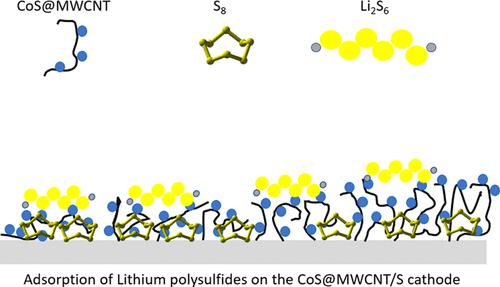当前位置:
X-MOL 学术
›
Ind. Eng. Chem. Res.
›
论文详情
Our official English website, www.x-mol.net, welcomes your
feedback! (Note: you will need to create a separate account there.)
Facile Synthesis of CoS Nanoparticles Anchored on the Surface of Functionalized Multiwalled Carbon Nanotubes as Cathode Materials for Advanced Li–S Batteries
Industrial & Engineering Chemistry Research ( IF 3.8 ) Pub Date : 2022-06-20 , DOI: 10.1021/acs.iecr.2c01222 Zhao Wang 1 , Wenduo Zeng 1 , K. Y. Simon Ng 1
Industrial & Engineering Chemistry Research ( IF 3.8 ) Pub Date : 2022-06-20 , DOI: 10.1021/acs.iecr.2c01222 Zhao Wang 1 , Wenduo Zeng 1 , K. Y. Simon Ng 1
Affiliation

|
The effects of CoS loading (10, 20, and 30%) on multiwalled carbon nanotubes (MWCNTs) on electrochemical performance for Li–S batteries were investigated. A facile hydrothermal method was used to grow CoS nanoparticles in situ on the surface of MWCNTs. In addition, CoS on functionalized multiwalled carbon nanotubes (f-MWCNTs) was also investigated. Scanning electron microscopy, transmission electron microscopy, X-ray diffraction, and X-ray photoelectron spectroscopy were used to characterize the structure and electronic state of CoS on the surface of MWCNTs and f-MWCNTs. The initial discharge capacities and reversible specific capacities after 200 cycles were found to be 980 and 612 mAh/g, 990 and 707 mAh/g, and 959 and 658 mAh/g for the 10, 20, and 30% CoS samples, respectively. Interestingly, the 20% CoS@MWCNTs show the best initial discharge capacity and retention after 200 cycles. This finding can be attributed to the fact that high CoS loading (30%) may not be dispersed evenly on the MWCNT surface, while low CoS loading (10%) leads to fewer CoS and weaker adsorption for polysulfides. Moreover, the 20% CoS/f-MWCNTs show even higher initial discharge capacities of 1103 mAh/g and reversible specific capacities of 796 mAh/g after 200 cycles. This can be attributed to a rougher surface with more active sites on f-MWCNTs for trapping polysulfides and for enhancing the electronic conductivity of the cathode composite. X-ray photoelectron spectroscopy (XPS) spectra show prominent peaks at 162.7 and 163.9 eV, which correspond to Co–S and C–S bonds, respectively, suggesting that CoS bonds well with MWCNTs. It is postulated that CoS/f-MWCNTs play a role in adsorbing lithium polysulfides (LPS) during the charge and discharge process and accelerating the kinetics of polysulfide conversion.
中文翻译:

锚定在功能化多壁碳纳米管表面的 CoS 纳米粒子作为先进锂硫电池正极材料的简便合成
研究了多壁碳纳米管 (MWCNTs) 上的 CoS 负载量(10%、20% 和 30%)对 Li-S 电池电化学性能的影响。使用简便的水热法在 MWCNTs 表面原位生长 CoS 纳米颗粒。此外,还研究了功能化多壁碳纳米管(f-MWCNTs)上的 CoS。扫描电子显微镜、透射电子显微镜、X 射线衍射和 X 射线光电子能谱用于表征 MWCNTs 和 f-MWCNTs 表面上 CoS 的结构和电子状态。对于 10、20 和 30% CoS 样品,200 次循环后的初始放电容量和可逆比容量分别为 980 和 612 mAh/g、990 和 707 mAh/g,以及 959 和 658 mAh/g。有趣的是,20% CoS@MWCNTs 在 200 次循环后表现出最佳的初始放电容量和保持率。这一发现可归因于高 CoS 负载 (30%) 可能不会均匀地分散在 MWCNT 表面上,而低 CoS 负载 (10%) 导致 CoS 较少和对多硫化物的吸附较弱。此外,20% CoS/f-MWCNTs 在 200 次循环后表现出更高的初始放电容量(1103 mAh/g)和 796 mAh/g 的可逆比容量。这可归因于 f-MWCNT 上具有更多活性位点的粗糙表面,用于捕获多硫化物并增强阴极复合材料的电子导电性。X 射线光电子能谱 (XPS) 光谱在 162.7 和 163.9 eV 处显示出显着峰,分别对应于 Co-S 和 C-S 键,表明 CoS 与 MWCNT 键合良好。
更新日期:2022-06-20
中文翻译:

锚定在功能化多壁碳纳米管表面的 CoS 纳米粒子作为先进锂硫电池正极材料的简便合成
研究了多壁碳纳米管 (MWCNTs) 上的 CoS 负载量(10%、20% 和 30%)对 Li-S 电池电化学性能的影响。使用简便的水热法在 MWCNTs 表面原位生长 CoS 纳米颗粒。此外,还研究了功能化多壁碳纳米管(f-MWCNTs)上的 CoS。扫描电子显微镜、透射电子显微镜、X 射线衍射和 X 射线光电子能谱用于表征 MWCNTs 和 f-MWCNTs 表面上 CoS 的结构和电子状态。对于 10、20 和 30% CoS 样品,200 次循环后的初始放电容量和可逆比容量分别为 980 和 612 mAh/g、990 和 707 mAh/g,以及 959 和 658 mAh/g。有趣的是,20% CoS@MWCNTs 在 200 次循环后表现出最佳的初始放电容量和保持率。这一发现可归因于高 CoS 负载 (30%) 可能不会均匀地分散在 MWCNT 表面上,而低 CoS 负载 (10%) 导致 CoS 较少和对多硫化物的吸附较弱。此外,20% CoS/f-MWCNTs 在 200 次循环后表现出更高的初始放电容量(1103 mAh/g)和 796 mAh/g 的可逆比容量。这可归因于 f-MWCNT 上具有更多活性位点的粗糙表面,用于捕获多硫化物并增强阴极复合材料的电子导电性。X 射线光电子能谱 (XPS) 光谱在 162.7 和 163.9 eV 处显示出显着峰,分别对应于 Co-S 和 C-S 键,表明 CoS 与 MWCNT 键合良好。











































 京公网安备 11010802027423号
京公网安备 11010802027423号